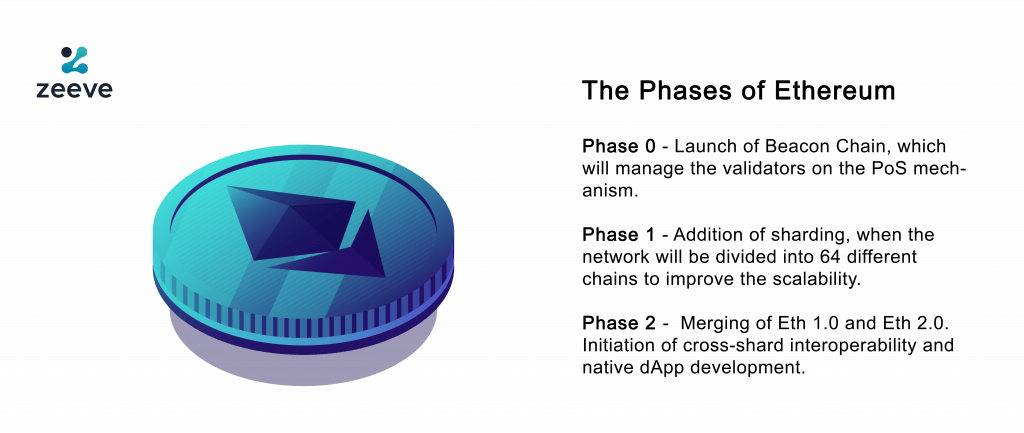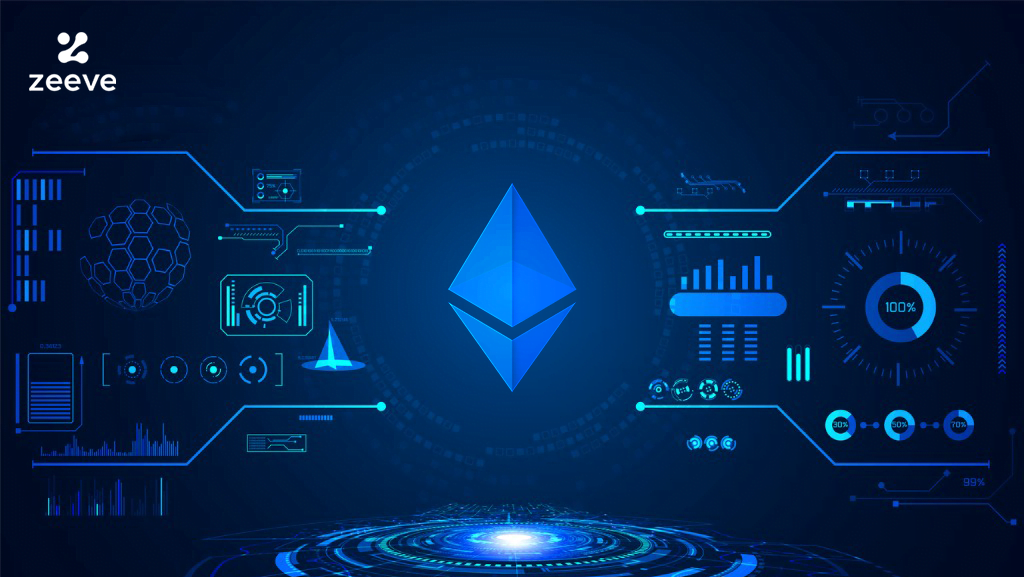In the blockchain space, Ethereum has a significant role to play. Home to numerous Defi projects, NFTs, dApps, and offering digital money on a global scale. The permissionless blockchain has millions of users and has a market of more than 250 billion.
The previous Ethereum marked the birth of second-generation technology. With its unprecedented efficiency, the network empowers many industries such as healthcare, banking, education, finance, gaming, supply chain, and many more. But in 2022 to give its users faster transaction speed and sustainability. Ethereum is deciding to roll out Ethereum 2.0, also known as “Serenity,” “Eth 2.0,” or the “New Ethereum”.
The New Ethereum has raised several questions regarding its execution. In this blog, we will understand the need for updating Ethereum. The merge between the old and new Ethereum. The features of Ethereum 2.0 and finally, how Ethereum is helpful for enterprises. We will also have a look at the centralization of the network.
An Introduction to Ethereum
Let’s quickly refresh our knowledge on Ethereum. It was launched in 2015 by Vitalik Buterin, a Canadian-Russian programmer. Ethereum is an open-source and decentralized blockchain platform. The platform works on the smart contract functionality and establishes a peer-to-peer network among its users.
With the popularity of smart contracts by Ethereum, the execution of DApps became possible. In addition, it also paved the way for blockchain-based games and many other applications. Recently, the blockchain platform will get a renewal in 2022 with a change in its consensus mechanism.
Why an update?
Both Bitcoin and Ethereum were known for their proof-of-work (PoW) consensus mechanism. The mechanism was energy-inefficient as all the computer networks were required to generate new blocks through mining.
PoW mining is competitive and expensive as well. Using Application-Specific integrated circuits(ASIC) or Graphical Processing Units(GPU) took a significant amount of time for mining. Thus the mechanism gradually proved to be slow, energy-degrading, and costly.
The scalability factor was also one of the factors for an update. While the previous Ethereum network only assists 15-30 transactions per second. Ethereum’s new Proof-of-stake(PoS) can assure 100,000 transactions per second. The current Eth 1.0 version is updated to improve the bottlenecks in the existing system.
Ethereum 2.0
Ethereum 2.0 is not entirely a new blockchain. It’s just a new update on the existing mechanism. The governance mechanism of the network is changed from proof-of-work to proof-of-stake. Some industry-leading networks already work on PoS, such as Polkadot, Solana, Cardano, etc. The PoS network is more secure and sustainable. However, to avoid any confusion between Ethereum Mainnet and Beacon Chain — by August 2022, we may all witness the merger between the two.
The Merge of Eth 1.0 and Eth2.0
The Ethereum Foundation cleared the air around Ethereum 2.0 by stating that Eth 1.0 is the “execution layer” and Eth 2 is the “consensus layer.” The Ethereum Foundation is more inclined on the side to merge both the networks rather than separate them. Thus, naming it “Ethereum Merge.” They also did the rebranding to make the developers understand the roadmap of the Ethereum 2.0 evolution.

What is Sharding?
Sharding is the process in which one blockchain is divided into various blockchains. Thus, one network works as a single validator. Therefore instead of executing all transactions through a single blockchain, it can be done across several side chains. This will make the process more energy-efficient.
The multiple blockchain networks on Ethereum 2.0 are known as “Shards.” In the process of sharding, each validator has to maintain their shard. Furthermore, the validators are mixed to prevent the manipulation of the data. Finally, a chain called Beacon Chain is used for coordination and communication between the validators.
The splitting of the blockchain will make effective use of the computing powers. However, sharding needs to be appropriately executed; otherwise, malicious actors may take over the validators of the side chains.
What is Staking?
Staking is also a term related to the PoS consensus mechanism. The process secures the blockchain and generates new blocks. The process of selecting a validator is known as staking. The validators have to generate a new block and earn staking rewards.
Advantages of new Ethereum 2.0
Here are a few of the advantages of the Ethereum 2.0 network:
Better security
The update will secure the platform for investors, and enterprises, as we all have witnessed hacking on the previous Ethereum blockchain network.
Improved Scalability
The blockchain hosts a plethora of DApps and DeFi services. Almost 70% of DeFi runs on the Ethereum chain. Due to this, there is always massive traffic. The previous network had a delayed network and high transaction fees. The upgrading to PoS will reduce those issues.
Better Sustainability
The earlier network wasn’t eco-conscious at all. Miners used computing devices that consumed a lot of electricity. However, the current Eth 2.0 is energy-efficient.
Differences between Ethereum & Ethereum 2.0
- The Ethereum blockchain now randomly selects an ETH holder. The selected validator is being given the responsibility of hashing a new block. Anyone with a certain amount of ETH can now participate in staking new tokens, which will lead to more decentralization, according to the Ethereum Foundation.
- Sharding is present in Ethereum 2.0, where the data is distributed among various machines. Through that, the speed gets improved. Thus the workload is getting distributed. Multiple databases have given Ethereum a speed of 100,000 transactions per second. In sharding, consider the one chain getting divided into 64 chains. This will speed up the Ethereum network.
- Beacon Chain is the central component of the Ethereum 2.0 blockchain. It nominates the next validator. It also slashes the staked amount if there is an exploitative attempt. Thus, increasing the security of the current version of Ethereum 2.0.
Moving from Eth1.0 to Eth 2.0?
Any of the apps existing on the Ethereum network will only have to migrate to 2.0. Through this move, there will not be any loss of the transaction records. Thus, there will be less fee structure, leading to more users.
Enterprise blockchain on Ethereum
Worldwide Business blockchain networks thrive on the Ethereum codebase. The Ethereum codebase can be used by businesses worldwide to form business blockchain networks. These can be private, permissioned, and utterly different from their public counterparts.
From tracking transactions and tracing real-world goods, this is an extension to the public Ethereum providing enterprise-focused solutions.
Ethereum differs from the famous enterprise blockchain solutions such as Hyperledger and R3 Corda. Here are a few of the features enterprises built on Ethereum blockchain experience:
- The Ethereum network supports more inclusivity and participation. You would not believe there are more than 2000 dApps on the Ethereum network. It has the most robust network and supports popular development platforms such as Truffle.
- The enterprises built on Ethereum get a bridge to the mainnet Ethereum due to the interoperability. The privacy and the scalability it further offers are customizable.
- Due to the connection with the mainchain, enterprises can connect with thousands of dApps. The companies with Ethereum can run on the private system but link the whole to a public network. This will provide more control over the environment.
- The smaller private networks can be considered a sidechain and the mainchain a vault. Thus, the plasma chain can transfer the asset from the mainnet to a private chain. This will aid in adding the root layer security of the enterprise blockchain.
Centralization in Ethereum 2.0
One of the ethos of Ethereum is decentralization. Although, PoS networks are known for their small set of validators. Thus, it has lesser network security and supports a centralized network. However, Ethereum 2.0 has more than 16,000 validators. Consequently, creating a decentralized environment due to its large user base.
But the question still surrounds “would Ethereum 2.0 lead to centralization?” To answer the question, we need to understand about Lido. It is a staking-as-a-service provider and is one of the most-used liquid staking protocols.
As the PoS requires staking rather than mining on Ethereum. In order to earn a stake and run a validator, participants need to stake 32 ETH. The 32 ETH approximately equals $38402 today. By using Lido users can use any amount of ETH to earn staking on Beacon Chain. Now, this can cause the centralization of the network. Danny Ryan, chief researcher at Ethereum, tweeted about explaining Lido’s move & how it is exploiting the system.
Downsides of the Ethereum 2.0
Vitalik Buterin said in a podcast that dealing with the validators is one of the current challenges they are facing. Other than that, the merging Eth 1.0 with Eth 2.0 creates confusion among enterprises, investors, and others.
It’s also the first time that proof-of-stake is being used on such a large scale, requiring Ethereum to come up with multiple audits on its framework. Also, the end of mining on Ethereum is still not an advantage as a few corrupt stakers can stake more ETH and validate more blocks.
Wrapping Up!
This update has strengthened the foundation of Ethereum. The final merge will occur somewhere between June to August 2022. Although, there isn’t a final date. The change in consensus mechanism offers scalability, transparency, and enhanced security on the network. This will be a lucrative deal for enterprises, organizations, and individuals.
There is still a lot to be done regarding the slashing of validators on the centralized network. If all goes according to Ethereum’s plan, then the new Ethereum 2.0 will remain on its spot as the largest enterprise blockchain ecosystem to date. Till then, a few rounds of the additional improvements need to be done on the Ethereum 2.0 platform.
About Zeeve
Zeeve supports the deployment and monitoring of all types of Ethereum networks — Mainnet, Ropsten, Rinkeby, Kovan over the cloud of your choice. We also provide detailed cloud monitoring alongside Ethereum parameters, which helps maintain your node’s uptime.
We are a leading blockchain infrastructure company supporting businesses and blockchain-based start-ups to create, deploy, and manage decentralized applications and blockchain networks. We have cost-effective and easy-to-adopt packaged solutions for enterprises.
Zeeve is a low-code automation platform that supports the backends of several blockchain protocols and provides comprehensive analytics. It not only deploys and builds the blockchain networks but also supervises their nodes.
Get in touch with our team to learn about our blockchain sharing, managing, and deploying infrastructure platform.






















